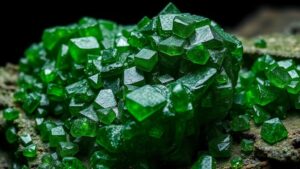Searching for rare green beryl in the remote valleys of Zimbabwe.
Searching for Rare Green Beryl in the Remote Valleys of Zimbabwe
Zimbabwe, known for its stunning landscapes and rich mineral diversity, offers rockhounds and mineral collectors an opportunity to search for the rare green beryl gemstone. With its exceptional clarity and vibrant hue, green beryl, particularly in its emerald form, is a sought-after specimen in the mineral collecting community. In this article, we will navigate the key aspects of searching for green beryl in Zimbabwe’s remote valleys, providing practical tips and essential insights for enthusiasts.
The Geological Context of Green Beryl
Green beryl is a beryllium aluminum silicate that forms in pegmatitic environments, often in association with minerals such as quartz, tourmaline, and garnet. mineral is typically found in regions with granitic and metamorphic rocks, making Zimbabwe’s geological profile particularly conducive to the formation of this gem quality mineral.
According to geological surveys, the prominent pegmatite deposits in Eastern Zimbabwe, especially the areas surrounding the Manicaland region, serve as prolific sources for beryl varieties. The chemical composition of green beryl typically includes iron, which contributes to its green color; the presence of chromium can lead to an even more valued emerald hue.
Identifying Green Beryl in the Field
When searching for green beryl, it’s crucial to recognize its distinct characteristics. Here are some identifying features:
- Color: Green beryl ranges from pale green to deep green, with deeper hues typically commanding higher values.
- Transparency: High-quality green beryl gemstones are transparent to translucent, exhibiting excellent clarity free from inclusions.
- Crystal Structure: Beryl crystallizes in the hexagonal system, often forming elongated hexagonal prisms.
To maximize your chances of finding green beryl, focus on areas where pegmatitic rocks are exposed, such as stream beds, road cuts, and hill slopes. Evidence of past mining activity can also indicate promising sites for exploration.
Tools and Techniques for Collectors
Equipping yourself with the right tools can significantly enhance your collecting efforts for green beryl. Essential tools include:
- Geological Hammer: A sturdy hammer allows you to break rock samples and extract potential beryl specimens.
- Hand Lens: A magnifying glass helps in examining the clarity and features of the beryl.
- GPS Device: Keeping track of your location is vital, especially in remote areas.
- Safety Gear: Protective clothing, gloves, and safety goggles are essential when breaking rock.
Also, employing a systematic approach to searching–such as grid sampling–can increase your efficiency. By carefully documenting the locations and conditions of your findings, you can glean insights for future expeditions.
Legal Considerations and Ethical Mining
Before embarking on your search for green beryl, its important to be aware of the local laws governing mineral collection. In Zimbabwe, all mineral exploration and collection require proper permits, especially in protected areas. Getting acquainted with the relevant legislation not only ensures legal compliance but also encourages sustainable practices in rockhounding.
Ethical collecting means respecting the environment and local communities. Always leave the area cleaner than you found it and ensure any specimens taken do not negatively impact local ecosystems.
Real-World Applications and Market Demand
Collecting green beryl not only satisfies a personal passion but can also be a lucrative endeavor. global demand for gemstones continues to rise, with green beryl being sought after in both jewelry and for decorative purposes. In 2023, the average price for high-quality green beryl can exceed $400 per carat, making it a worthwhile pursuit for collectors.
Also, regions in Zimbabwe are looking to boost eco-tourism and artisanal mining, which can create opportunities for collectors to engage in responsible practices that benefit local economies. Investing in these experiences not only enhances your collection but also supports the local culture and resources.
Actionable Takeaways
- Plan your expedition to remote valleys in Zimbabwe, focusing on geological formations conducive to beryl deposits.
- Acquire the necessary permits before conducting any collecting activities.
- Familiarize yourself with the identifying features of green beryl to differentiate it from other minerals.
- Use appropriate tools and techniques to maximize your productivity while ensuring safety.
- Engage with local communities and support sustainable practices to enhance your collecting experience.
To wrap up, the search for rare green beryl in Zimbabwe offers an exciting adventure for rockhounds and mineral collectors alike. By understanding the geological context, employing proper techniques, and adhering to ethical practices, collectors can appreciate both the beauty and the complexity of the natural gemstone landscape.



